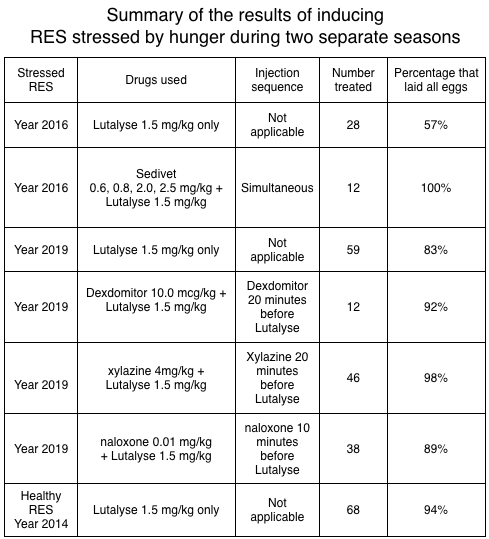Alpha-2 agonists and stressed turtles
The table below illustrates that the alpha-2 agonist Domitor (medetomidine), when added to oxytocin + Lutalyse (PGF-2), seemed to be no more effective with RES than oxytocin + Lutalyse alone. However, that poor outcome was caused by the sequence of injection. Because we gave the Domitor after the mix of oxytocin and PGF-2 the laying process was disturbed. We would learn later that we should have given the Domitor first.
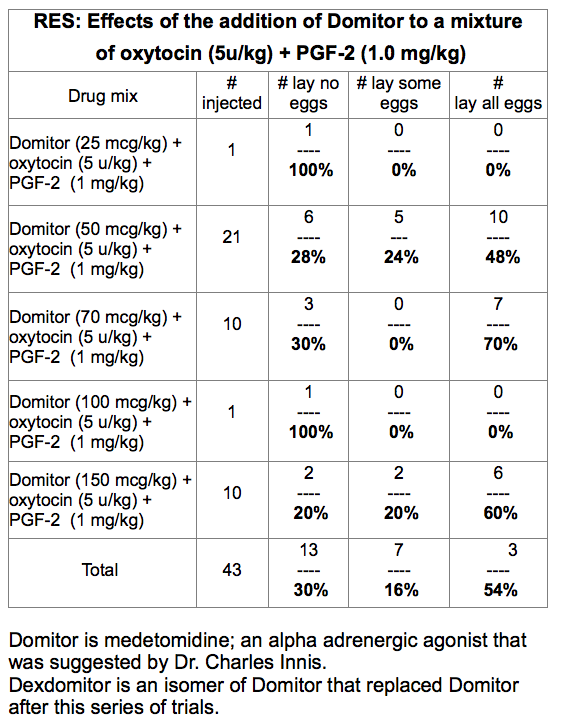
Years later, when working with softshells and snapping turtles, and injecting the alpha-2 agonists first, the alpha-2 agonists proved to be critical to achieving a successful outcome. We will detail those result later under the heading “The drugs we tested on SSS (spiny softshell turtles).”
Shortly after we first worked with Domitor it was removed from the market and replaced by the isomer Dexdomitor (dexmedetomidine) which was about twice as potent as Domitor. After that change we experimented with Dexdomitor and two other alpha-2 agonists: xylazine and Sedivet (romifidine). The first challenge was to determine the appropriate dosage range for our trials. We did that by reviewing the recommended doses for various small animals and then testing a range around those varied recommendations. Then we compared our results with each of these agents to the results with each of the other agents to see if the doses were roughly proportional.
Safety was the first issue to address. We used a “white handkerchief test” to judge the degree of sedation produced by the alpha-2 agonist xylazine. We would wave a white handkerchief in front of the soft shell turtle’s snout and, if it failed to respond, we judged it to be sedated. When working with SSS the sedating dose for xylazine was 10mg/kg. This was above the most effective dose of 6-8 mg/kg shown in the table below. The turtles in the table below were given the xylazine 20 minutes before the Lutalyse. Doses up to 12mg/kg were tested and found to be safe. In all cases, whatever sedation that was present resolved before we released the animals the following morning, without using any reversal agents.
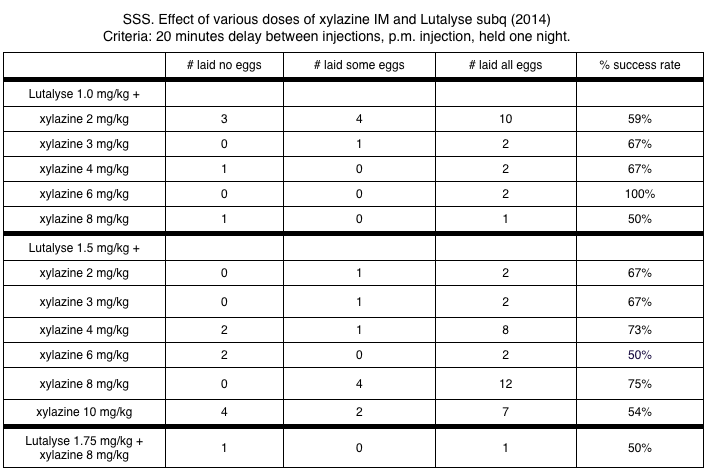
A rare opportunity presented itself when the Concordia Turtle Farm acquired a small number of RES that were underfed from a failed turtle farm in 2016. We defined these animals as stressed. These stressed animals responded poorly to Lutalyse alone as shown in the table below.

However, our results improved dramatically when we added an alpha-2 agonist. This gave us an opportunity to trial a wide range of dosages of the alpha-2 agonists in these RES. Because of the poor results with these stressed RES when we used Lutalyse alone we had some initial concern that there was something wrong with the Lutalyse. So we tested a small number of yellow bellied sliders (Trachemys scripta scripta) and Cumberland sliders (Trachemys scripta troostii) with that bottle of Lutalyse. The results in the chart below show these turtles had a 100% success rate so we knew the Lutalyse was effective.

As mentioned before, these alpha-2 agonist trials would not be useful with healthy RES because the success rate with Lutalyse alone was 94%, so we would have had to process hundreds of animals to detect an effect from adding the alpha-2 agonists to the Lutalyse. However, later on, we did test various doses of the alpha-2 agonists when we worked with healthy spiny softshell turtles; a species less responsive to Lutalyse alone. That work is detailed in the section labeled “The drugs we tested on SSS (spiny softshells).”
We began our work with alpha-2 agonists in stressed RES by testing a variety of doses of xylazine used alone for safety. The results are shown in the chart below.
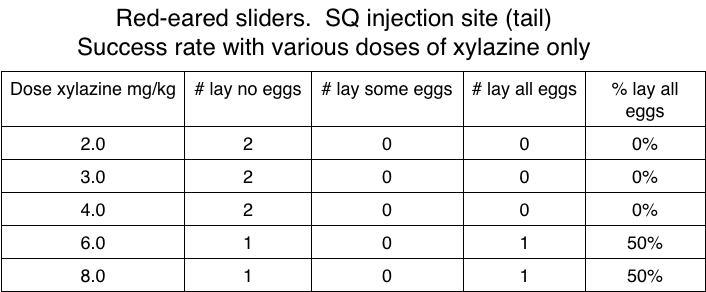
All the doses we used were safe and the higher doses of 6-8 mg/kg actually induced some egg laying. We then tested Lutalyse alone with a small number of these stressed animals. As the table below shows, the success rate was only 57%; far below the 94% success rate we achieved with a large sample of healthy RES.

Being cautious, we then combined xylazine and Lutalyse in a small group of these stressed turtles with no mortality or morbidity and an improved success rate. Those results are shown in the chart below.
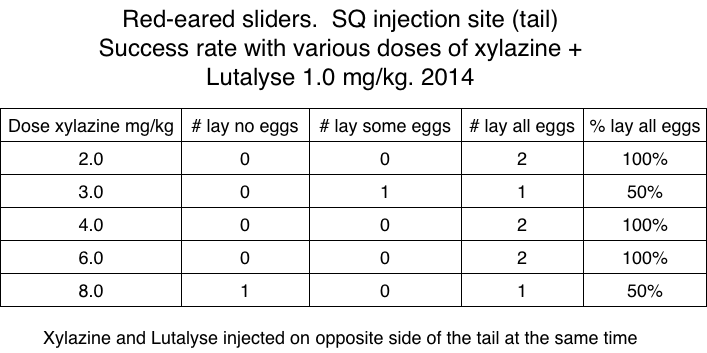
Feeling more confident with the safety of the alpha-2 agonists, we experimented with a wide range of doses of Sedivet in these stressed turtles as shown in the table below. We got excellent results with 100% success rates with a variety of dosages. Unfortunately, the numbers of turtles were low, but there was clearly a dramatic improvement in the success rate.
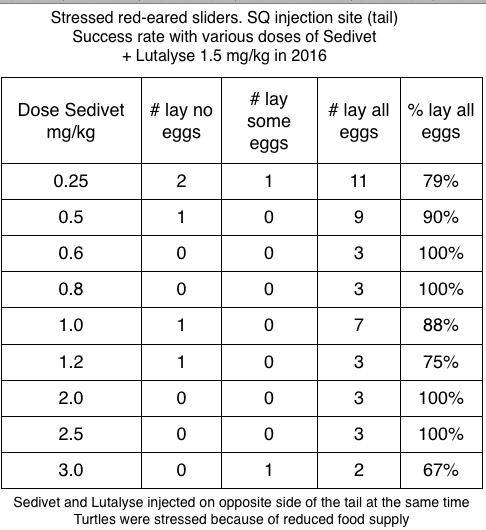
In 2019 we again had an opportunity to work with stressed RES that were also underfed but in somewhat better condition than those we tested in 2016. In 2019 the success rate with these stressed turtles with Lutalyse alone was 83% as shown in the chart below.

We then induced 139 turtles over a two week period with Lutalyse 1.5 mg/kg combined with various doses of xylazine as shown in the table below. When Lutalyse was given 20 minutes after 4mg/kg of xylazine the success rate jumped to 98%.
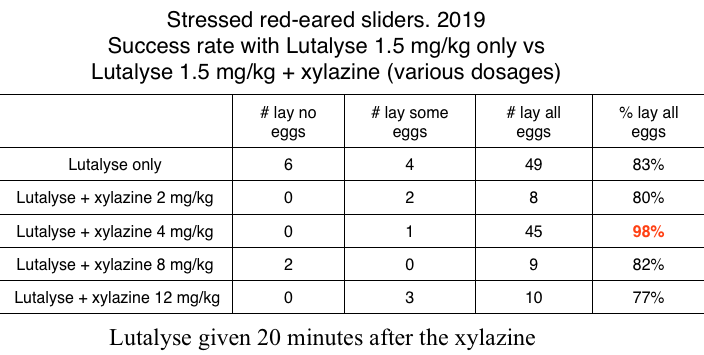
There were limited numbers of these stressed RES and that forced us to use reduced numbers in our trials with the alpha-2 agonist Dexdomitor. As you can see in the table below, Dexdomitor increased the success rate but Sedivet had been more effective in 2016 (third table above).
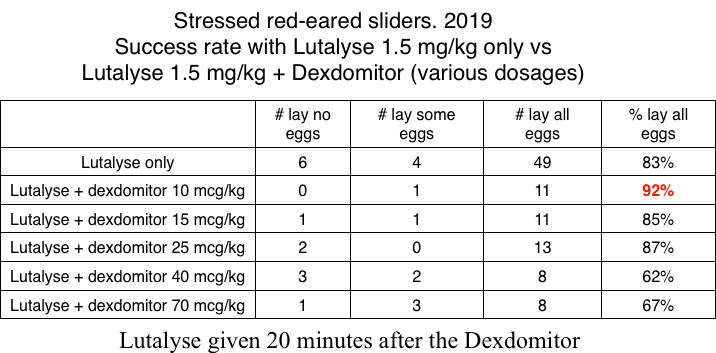
Both these trials suffered from low numbers but it was a unique opportunity that we could not repeat. As you will read in the section labeled “The drugs we tested on SSS,” we achieved similar relative success rates in spiny softshell turtles with Sedivet being the most effective agent. The fact that Sedivet yielded the best results of the three alpha-2 agonists we used may reflect its longer duration of action.
Narcan is the brand name for naloxone, an opioid receptor antagonist. Since narcotics relax smooth muscle we wondered if an opioid blocker would stimulate oviductal smooth muscle and help induce egg laying in the stressed RES. We tried a variety of doses of Narcan given ten minutes before the Lutalyse. As you can see from the table below it had a positive effect but not as much as the alpha-2 agonists.
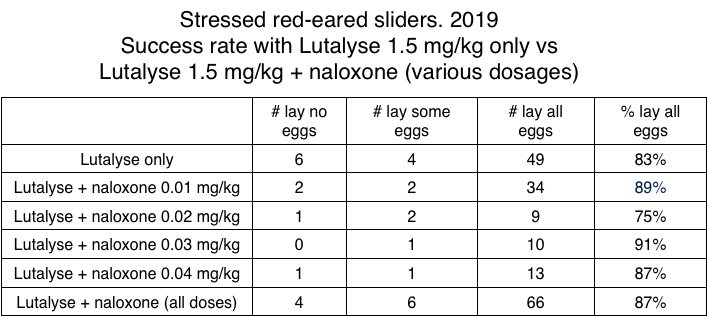
The table below is a summary of all the results with stressed turtles.
